
Wine Culture and Information since 2002 - Volume 22
 Wine Culture and Information since 2002 - Volume 22 |
|
Issue 49, February 2007 |
Contents |
|
|
Italian Wine: Higher and Higher! |
|
Italian wine has walked a long way. Since the beginnings of Italian enology, wines produced in the boot were appreciated for their quality and many authors of the past have praised them in their writings. Wines which made dream the men living in past times, exported and appreciated everywhere in what was considered - at those times - the known world. Wine was also one the first things produced in Italy to be exported outside the borders of the country, then - as everyone knows - the beverage of Bacchus was followed by other products, art and culture. Wine, after all, fully represents the culture and the expression of the ones making it, therefore - since those times - together with wines was also exported the Italian culture, or at least of that territory that will be called in later times Italy. Then, the fairy tale underwent a time of deep decline, the splendor of Italian enology passed the dark times of the Middle Age and - with alternate fortunes - has come to our days, after having undergone a very long period of productive logic in which quantity was more important than quality. During this period, the name of Italy abroad was however kept “high” by other productions, by the delicacies of the Mediterranean cooking, clothes, Italian style and by all the other products generically classified as “made in Italy”. Among them there was also wine, but its role was certainly marginal, so far from what it was and from what it represented in past times. The decline was not only because of the way wine was generally produced in Italy - lots of quantity and disputable quality - and the few producers who made quality the primary characteristic of their wines, had a pretty hard time in selling their wines, in particular abroad, because of the not very noble fame of Italian wines. And while in Italy they mainly thought about making oceans of ordinary wine, the other countries - including the ones of the so called “New World” - were taking giant steps forward in terms of quality, progressively getting more and more marketing shares as well as building up a solid fame of quality producers. In the last 25 years the world of Italian wine - luckily - has lived a revolution in every aspect, both because of the will of some producers who believed in revaluating the enology of this country, as well as because of the increasing interest for Italian wine. These two events, including the renewed worldwide interest for the beverage of Bacchus, have started a change which can be defined as epochal, literally changing the production criteria and - thanks to the progressive introduction of modern technologies and wine making techniques - Italian wine has resumed its way towards quality, “suspended” for a very long time. The reprise towards quality has begun - at the beginning of the 1980s - with white wines, also helped by the fashion of the moment, followed by red wines and, in recent times, by the excellent production of classic method and Charmat sparkling wines, particularly concentrated in northern Italy. Even though slowly, Italian wine was attracting the attention of foreign markets again, conquering, once again, the dignity and the role which in past times distinguished Italy. however competition was - as it was easily predictable - pretty tight: progresses obtained by the other countries of the world were surprising and certainly not easy to surpass. Also because the enological production of the competing countries was - and still is today - of excellent quality, therefore consumers, in front of the possibility of choosing a series of products, they prefer, of course, the ones having the higher quality and possibly sold at the most convenient price. A non easy scenery, of course, in which if they would have simply relied on the “made in Italy” branding - still attracting in every country of the world - this was not enough to ensure to Italian wine a renewed success. It was the time to show facts, not only words. And the facts have finally arrived. Since many years the quality of Italian wines has indisputably reached levels such to be superior than the one of the many wines coming from the other countries of the world. Whether it was because of the “made in Italy” branding or not, the charm of culture and Italian tradition, this is not important at all: the result is clear without trying to find a reason or merits somewhere else. Also the figures about the export of Italian wines abroad are very clear. The statistics about the export of Italian wine in 2006 say there was an increase of 13% about quantities and an increase of 9% about profits than 2005. If we consider the holiday period which has just passed - a period in which the sale of sparkling wines increases considerably - the results obtained by bubbles in foreign country are surprising. The sale of Italian sparkling wines in 2006 have recorded an increase of about 17% in quantity and 13% in profits. A result which confirms, once again, the progresses and the results obtained by Italian bubbles, both classic and Charmat methods. Italian bubbles are getting more and more successful in Japan, acquiring more and more market shares in the country of the rising sun. In Germany Italian wine has considerably increased export, and now it represents the larger share in German market, followed by France and Spain. In the other side of the Atlantic ocean are being recorded encouraging results as well. In the United States of America the sales of Italian wine has considerably increased, including the interest of knowing the history, tradition and the wine areas of Italy. In fact, whereas the situation of the export of Italian wine in the country of the European Union can be considered pretty stable, export has considerably increased in all those countries outside the Union. The first ranking of export is occupied by red wines and, progressively increasing, sparkling wines, an indisputable sign the bubble produced in Italy have reached high quality levels. This is what has been reported by the ICE - Istituto Nazionale per il Commercio Estero, National Institute for Foreign Commerce - about the export of Italian wine abroad. In this scenery, it is also found out the main share of wine export goes to the regions of northern Italy - representing more than 70% - whereas the export of southern regions is a little more than 5%. A surprising result, by considering the good production of southern regions, in particular of red wines. The good trend of the export of Italian wine in the world is certainly something which confirms the remarkable progresses Italian enology did for quality. The confirmation the hard and tenacious work done by producers for the success of Italian wine was effective and that quality was the main thing asked by wine lovers. The wish is that the result will be confirmed in 2007 as well and that quality of Italian wine will be increased, not only for the joy of the countries of the world in which it is being exported, but also for the joy of wine lovers in Italy. Alla salute!
|
||||
MailBox |
|
In this column are published our reader's mail. If you have any comment or any
question or just want to express your opinion about wine, send your letters to
our editorial or fill in
the form available at
our site.
|
| How is Sciacchetrà produced? How should this wine be served? |
| David Matteoli -- Meadow Vista, California (USA) |
| Sciacchetrà - according to the local dialect should be called Sciachetrà - is a wine produced in the Cinque Terre, Liguria, locally known as rinforzato (refursà, reinforced). Sciacchetrà is produced with Bosco, Vermentino and Albarola grapes, allowed to dry after harvesting in order to diminish the quantity of water while concentrating sugar. The grapes are then pressed and vinified, therefore obtaining a sweet and thick wine. Sciacchetrà must age at least one year before being commercialized, whereas the Sciacchetrà Riserva requires at least three years. Sciacchetrà is generally served at a temperature of 14° C (57° F) in small dessert wine glasses and it is a good match for confectionery and hard and piquant cheese. |
| It is said Champagne must be served in the flûte glass and at a temperature of 6-8° C (42-46° F). Does this not excessively penalize aromas? |
| Hiroshi Yoshida -- Kyoto (Japan) |
| Champagne is generally served in a flûte glass at a pretty low temperature in order to favor one of the aspects considered to be more elegant for this wine: perlage. The development of carbon dioxide is in fact favored in tall and narrow glasses, with a pretty pointed base, whereas low temperatures avoid the sudden dispersion of this gas, while ensuring a longer lasting of the development of bubbles. However these two characteristics excessively penalize the development and the perception of aromas, also because the flûte is generally filled completely. In the last years it is a common practice to use for Champagne, as well as for other great classic method sparkling wines, a wider flûte glass, in order to ensure not only the development of bubbles, but also a better development of aromas. Temperature has a primary role in the development of aromas and at low temperatures, also in case the wine is served in a wider glass, they are however penalized. For this reason, some bubbly lovers prefer serving these wines in larger glasses - the same used for aged white wines - at a temperature of 10-12° C (50-54° F). This solution penalizes the “show” of perlage, however allows Champagne to better express its aromatic qualities, a result of years of patient aging in bottle. |
Emilia-RomagnaThe placid region stretching along the Po valley, it is known for its rich cuisine, but also for its white, red, sweet and sparkling wines |
|
You talk about Emilia-Romagna and you think about its rich cuisine, delicious, tasty, exuberant, cordial and hospitable, just like the people living in this region. It is not only the rich and colored cooking of this region to distinguish Emilia-Romagna, but also art, culture and history, as well as the famous cordiality and hospitality of its inhabitants. In this context, so rich and complex, also wine has a specific role, here as somewhere else in Italy, the beverage of Bacchus plays a fundamental role in the culture of the region. The region is divided in two distinct geographical and cultural areas: Emilia, in the western part, and Romagna, in the eastern part. The two areas are not distinguished for the different cooking style only - in both cases rich and tasty - but also for the way they make wine, and therefore the grapes cultivated in vineyards. Emilia is the indisputable homeland of the many “Lambrusco”, sparkling red wines - or like they are used to call them, sharp and alive - which would certainly be better revaluated. In Romagna wine is mainly made dry and it is produced with Sangiovese, Albana and Pignoletto grapes, as well as other varieties.
The history of vine and wine in Emilia-Romagna has very ancient origins, dated back to the beginning of civilization and everything began, presumably, with the most famous grape of Emilia - the western part of the region - and from which it is produced one of the most famous Italian wines in the world: Lambrusco. This wild grape was known since Virgil's times, and also Pliny the Elder mentioned it in his Naturalis Historia. It was Virgil to tell - in his fifth bucolics - Vitis Labrusca was already known since two thousand years. Pliny the Elder recognized to this grape medical properties and he describes, for the first time, its characteristics. Some archaeological findings confirms the long history of Vitis Labrusca, thanks to the discovery of fossilized seeds and roots belonging to this species, dated back between the twentieth and tenth century b.C. Lambrusco can therefore be defined, with no doubt, the progenitor of viticulture in Emilia-Romagna. Despite this important archaeological discoveries, there are no reliable information about the use of Vitis Labrusca at those times for the production of wine. The first reliable information about the cultivation of vine and the production of wine in Emilia-Romagna are dated back to the seventh century b.C., at the times of the Villanovian civilization in Verrucchio, near Rimini. The archaeological findings in these areas have in fact allowed to reliably define that at those times the inhabitants of these lands practiced viticulture. Other important evidences about viticulture and production of wine in Emilia-Romagna are also dated back to the times of the Etruscan dominion. Another important evidence is offered by Varro in his De Re Rustica, where he wrote that in the Po valley, after the drainage works done in the area, here were cultivated Albana, Trebbiano, Cagnina and Spergola, varieties which produced huge crops of grapes. During the dominion of Gauls, viticulture will not significantly develop and only after the dominion of ancient Romans the cultivation of the vine and the production of wine will begin to develop. Viticulture undergoes a new development from the fifth century a.D. on, and it is dated back to this time the introduction from Dalmatia of the Refosco Terrano grape, known in Emilia-Romagna as Cagnina. After the Longobard invasions, in 568 a.D., viticulture and production of wine undergo a period of recession and it will be thanks to the work done by the many religious orders, here as everywhere else in Europe, the cultivation of vine and the production of wine will be kept from further recessions. A significative contribution to the viticulture of this region was done by the monastic order of Benedictine, in particular in the area near Ferrara, from whose activity, in later times, will be originated the viticulture of Bosco Eliceo. There are many interesting documents written in later times and in which are mentioned the many varieties found in the territory of Emilia-Romagna, in particular the Lambrusco varieties. From the seventeenth century on, there are many documents describing the many varieties of Lambrusco, at those times already considered a tamed variety and not a wild variety, widely used for the production of sharp and sparkling wines. In the 1800s, here as somewhere else, the arrive of phylloxera will stop viticulture. In this context, it is singular the case which happened in the delta of Po river, near the present territory of Bosco Eliceo DOC, where vineyards of Fortana grapes were not affected by this parasite and, still today, they are grafted in the original rootstock instead of American ones. With the end of sharecropping, in the 1900s, in Emilia-Romagna will be established, as well as in other Italian regions, small private estates and many cooperatives of producers, therefore beginning a production based on quantity and that will have Lambrusco as one of its protagonists. This long period of production based on quantity, will also determine the destiny of Lambrusco. If it is true this wine allowed Lambrusco to be known everywhere in the world, in particular in the United States of America, the disputable quality of these productions has originated the common belief this grape is used for the production of ordinary wines only. This prejudice is clearly denied by the many examples of quality productions made with Lambrusco grape. While the wineries of Emilia-Romagna were focused on the production of huge quantities of wine, in the 1960s some wineries tried to start a production of quality wines, a decision, perhaps, made too early at those times. In 1962, in order to safeguard the image of Romagna's wine, in Faenza was founded the “Consorzio Vini Tipici Romagnoli” (Consortium for Typical Wines of Romagna) which will then become “Ente Tutela Vini di Romagna” (Institute for the Safeguarding of Romagna's Wines), distinguished by the unmistakable mark of the “Passatore”, Stefano Pelloni, the famous bandit who lived in this land in the 1800s. In 1970 was founded another important institution, “Enoteca Regionale Emilia-Romagna”, which still today is in charge, by law, to the spreading and promotion of the wines of this region. The path for quality of wines in Emilia-Romagna will take in recent years two different although parallel ways, in which they will try to revaluate both the autochthonous varieties of the region, as well as by introducing the so called “international” varieties, most of the times used together with local varieties.
|
||||||||||||
|
The wines of Emilia-Romagna are classified according to the quality system in force in Italy, where, to the lowest level of the system, is found Vini da Tavola (Table Wines), followed by Indicazione Geografica Tipica wines (IGT, Typical Geographical Indication), Denominazione d'Origine Controllata (DOC, Denomination of Controlled Origin) and Denominazione d'Origine Controllata e Garantita (DOCG, Denomination of Controlled and Guaranteed Origin). In Emilia-Romagna are currently defined 20 Denomination of Controlled Origin areas and one Denomination of Controlled and Guaranteed Origin area recognized to Albana di Romagna, the first Italian white wine to achieve this ranking. The 20 DOC areas of Emilia-Romagna are: Bosco Eliceo, Cagnina di Romagna, Colli Bolognesi, Colli di Faenza, Colli di Imola, Colli di Parma, Colli di Rimini, Colli di Scandiano e di Canossa, Colli Piacentini, Colli Romagna Centrale, Lambrusco di Sorbara, Lambrusco Grasparossa di Castelvetro, Lambrusco Salamino di Santa Croce, Pagadebit di Romagna, Reggiano, Reno, Romagna Albana Spumante, Sangiovese di Romagna and Trebbiano di Romagna. The Colli Bolognesi denomination includes the following subareas: Colline di Oliveto, Colline di Riosto, Colline Marconiane, Monte San Pietro, Serravalle, Terre di Montebudello and Zola Predosa.
|
|
In Emilia-Romagna the production of wine is made in the whole regional territory, from the western borders to the eastern side of the Adriatic sea coast. Despite regional enology is focused on the production of wines with autochthonous grapes, here the presence of “international” varieties is pretty high, used both alone, as well as blended with local varieties. The enology of Emilia - the western part of the region - is traditionally associated to the production of sparkling wines, mainly from the many Lambrusco varieties. In the eastern part of the region - Romagna - the production is mainly about dry and sweet wines, both white, mainly produced with Albana, Pignoletto, Trebbiano Romagnolo and Pagadebit (Bombino Bianco) grapes, as well as red, mainly produced with Sangiovese grapes. Among the most common “international” varieties in Emilia-Romagna are mentioned: Chardonnay, Sauvignon Blanc, Cabernet Sauvignon and Merlot. |
|
Albana di Romagna was the first Italian white wine to receive the Denominazione d'Origine Controllata e Garantita (DOCG) ranking, reserved for the dry, “amabile” (slightly sweet), sweet and passito styles. The highest ranking achieved by this wine has always been cause of discordant opinions, as there are many detractors of this denomination, because they believe this wine is not worth to belong to the highest ranking of Italian enology. One of the most disputable points in the production disciplinary of Albana di Romagna, is represented by the maximum yield per hectare, currently set to 140 quintals, a value which clearly contrasts wine making quality criteria and that the DOCG ranking should ensure by law. With such a high limit, the quality which can be obtained is pretty disputable, and the best wines produced with this grape are the ones obtained with very low yields, a choice adopted by the best producers only. Of particular interest is the passito (sweet) style, probably the best wines in this denomination. |
|
Among the grapes which mainly distinguish the production of Emilia, there is the large family of “lambruschi”. The main representatives of this family are Lambrusco di Sorbara, Lambrusco Grasparossa and Lambrusco Salamino, to which are added Lambrusco Marani, Lambrusco Maestri, Lambrusco Montericco and Lambrusco Viadanese, this latter one common in the province of Mantua, in Lombardy. The Lambrusco grape begins to populate the vineyards of the province of Parma and it becomes the absolute protagonist in the ones of Reggio Emilia and Modena, areas in which Lambrusco has deep ties with the traditions of these places and, last but not the least, to the delicious cooking. The wine produced with Lambrusco is “dry” or “amabile” (slightly sweet), however sparkling, whose effervescence is generally obtained by natural fermentation. Despite Lambrusco is associated to the image of “ordinary” wine, there are many producers who, thanks to quality criteria, can make wines of remarkable interest and that should be properly revaluated. Lambrusco gives its best in the hilly areas near the medieval town of Castelvetro - in the province of Modena - where it is produced the Lambrusco Grasparossa di Castelvetro DOC. |
|
In Romagna, red wine means Sangiovese. There are many who believe Romagna is the land from which Sangiovese has originated. As it is commonly known, the name Sangiovese derives from “Sangue di Giove” (blood of Jupiter), and many believe the definition derives from monte Giove (Jupiter mountain), near Santarcangelo di Romagna, in the province of Rimini, where the grape was clearly cultivated. The results obtained with Sangiovese in the land of Romagna are extremely interesting, however showing organoleptic diversities, from light wines to wines with a good body, with a dry but strong taste. Sangiovese di Romagna was the first wine of the region to achieve the Denominazione d'Origine Controllata (DOC) ranking and it is produced in a pretty vast territory, from the province of Bologna to the eastern coast of the Adriatic sea. Sangiovese di Romagna produced in the best hills of the denomination having an alcohol by volume not lesser than 12%, can make use of the “superiore” indication, whereas in case it was aged for a period not lesser than two years, it can use in the label the “riserva” indication. |
|
Among the other wine production areas of Emilia-Romagna, one of the most interesting ones certainly is Colli Piacentini, in the area in which was found the gutturnium. It is a silver jug which gave the name to the most famous wine of this area, Gutturnio, produced with Barbera and Croatina grapes, here known as Bonarda. Among the other interesting wines of Colli Piacentini is mentioned Vin Santo di Vigoleno, a sweet wine produced in limited quantities with aromatic and non aromatic white berried grapes. Among the other areas, it is mentioned Reggiano, and in particular the Colli di Scandiano e Canossa denomination, where - besides wines made with Lambrusco grapes - are also produced interesting wines with “international” grapes. Going eastward, another interesting denomination is Colli Bolognesi, in which are being produced wines with autochthonous grapes, including Pignoletto, and wines with “international” grapes, in this area pretty common. Of particular interest is the production of IGT wines, in which the autochthonous grapes frequently meet international varieties, most of the times used alone as well.
|
Comparing SagrantinoConsidered the most representative grape of Umbria, Sagrantino makes great wines, of great character and personality, with rich and complex aromas |
|
In the last years Umbrian enology is mainly famous for one of its autochthonous grapes, precisely, a red berried grape, which is getting more and more successful in Italy and in the rest of the world. Sagrantino, today being one of the most famous sons of the green heart of Italy, is capable of making powerful and robust wines, with rich aromas that the patience of time will make complex, a success that in few years allowed it to reach the top of Italian enology. A singular case, if we consider this grape was about to disappear from the hills of Montefalco and to leave its place to other varieties, capable of ensuring higher yields and, in particular, a better commercial consensus. With its high contents in polyphenols - in this sense, Sagrantino is one of the most rich grapes known - it seemed quite an enterprise to create an “elegant” wine because of its astringency. For centuries, Sagrantino was used for the traditional wine of Montefalco, a sweet and robust wine which could well matched with the rich meat roasts and pecorino cheese, a tradition which is still today alive in these places. Few people would have believed from that grape one day would have been possible to make a dry wine, rich and powerful, which could compete, and frequently win, the challenge with other famous wines. The history of Sagrantino, in its “dry” style, it pretty recent - a little more than 30 years - and it took all the obstinacy and tenacity typical of the people living in Umbria, as well as the firm conviction of some producers who have always believed in their grape. Whether a time the most frequent association with Sagrantino was a sweet and robust wine, today it is its “recent” dry style to be associated the most - always imposing and robust - as to cast a shadow over the other excellent sweet style. Thirty years of successes, from unknown grape to famous and celebrated grape all over the world: a good revenge for a grape which was destined to disappear from the vineyards of Montefalco and no one wanted to cultivate it anymore.
|
|
Sagrantino is a red berried grape from Montefalco and its spreading is practically limited to part of Umbria only. Characterized by intense and pleasing aromas of blackberry, wines produced with Sagrantino grape can also be recognized for their full body and their evident astringency, a characteristic which frequently and negatively affects balance in case it is not properly “tamed”. For this reason, the vinification of Sagrantino di Montefalco provides for an aging period of at least 30 months, of which at least 12 in cask, sometimes replaced by barrique. The aromas which can be found in Sagrantino are usually exuberant and intense, first of all the one of blackberry - the most frequent and identifying aroma - as well as aromas of black cherry, plum and violet, including tertiary aromas developed during aging that with time will get an interesting complex character.
The purpose of our comparative tasting is to understand the organoleptic qualities of Sagrantino through the expression of three important producers of Montefalco: Arnaldo Caprai, Adanti and Antonelli. By comparing the three wines, we will understand the main organoleptic qualities of Sagrantino, despite the three wines are different one from each other in their “interpretation”. We will also understand the influence of wood in Sagrantino, as the three producers use different types of casks: Arnaldo Caprai's Sagrantino di Montefalco Collepiano is aged for 22 months in barrique, Adanti's Sagrantino for 26 months in cask, whereas Antonelli's Sagrantino ages for 15 months in cask. For our comparative tasting we will use in all the three cases the wines of the most recent commercialized vintage by the respective producers. The three wines will be served at a temperature of 18° C (65° F), in order to exalt the aromatic profile and to make astringency less aggressive. As usual, the tasting will be done by using three ISO glasses.
|
||||||||
|
Sagrantino is a particularly rich grape in coloring substances. This characteristic can be easily detected, in quality wines, by allowing a light source to pass through the glass while in the opposite side will be put an object - a pencil or simply a finger - in order to evaluate the low transparency. Transparency, as it usually happens in every wine, will increase with time, however it will be strongly affected by the quality of grapes used for the production of the wine. The color typically observed in Sagrantino is intense ruby red, frequently deep and dark as well, with nuances of the same color, frequently garnet red. Thanks to the high quantity of polyphenols, a quality requiring a proper alcohol by volume in order to ensure balance to the wine, Sagrantino can be aged in bottle for many years, a period during which, the color will change. With time, wines produced with Sagrantino will get bright garnet red hues and nuances of the same color or brick red. We will begin the evaluation of appearance from Antonelli's Sagrantino di Montefalco. By holding the glass tilted on a white surface - such as a towel or a sheet of paper - we will observe at the base of the glass the hue of color. It will be observed an intense ruby red color, with low transparency, whereas the nuances, observed at the edge of the liquid mass towards the opening of the glass, will be characterized by a garnet red color. The evaluation of the second wine's appearance, Adanti's Sagrantino di Montefalco, will reveal pretty similar color than the previous wine: intense ruby red and nuances of garnet red, also in this case, with a pretty low transparency. We will now pass to the evaluation of the third wine, Arnaldo Caprai's Sagrantino di Montefalco Collepiano. The color of this last wine, just like the previous ones, will be characterized by intense ruby red and nuances will be, once again, garnet red. Also in this case transparency will be pretty low, another confirmation about the high contents of coloring substances in Sagrantino.
|
|
The aromatic profile of Sagrantino is extremely interesting, both during the first years of aging, as well as after years of aging in bottle. The first aromatic qualities which can be recognized in Sagrantino are the ones of fruits, in particular blackberry, the most typical and identifying aroma in wines produced with this grape. Among the other typical fruit aromas of Sagrantino are also found plum, black cherry and blueberry, whereas the most typical flower aroma is violet. According to the production disciplinary, Sagrantino di Montefalco must be aged for at least 30 months, of which at least 12 months in cask, therefore the aromatic qualities of these wines will also be characterized by tertiary aromas. Besides vanilla, which is the most typical aroma in wines aged in wood - and in particular in barrique - in Sagrantino can also be perceived aromas of licorice, tobacco, chocolate, clover, cinnamon, leather, coffee and cocoa. Also balsamic aromas are frequent in Sagrantino and the most typical of them is menthol, rarely eucalyptus. The olfactory analysis of our comparative tasting will begin from Antonelli's Sagrantino di Montefalco. By holding the glass in vertical position and without swirling, we will proceed with the evaluation of opening aromas. The first smell will allow the perception of the aromas of blackberry, plum and black cherry, the most frequent and identifying aromas in Sagrantino, in particular, the one of blackberry. We will now swirl the glass in order to favor a proper oxygenation of the wine as well as favoring the development of all the other aromatic sensations. With the second smell will perceive the aromas of violet - the most typical flower aroma in Sagrantino - blueberry and cyclamen, followed by a series of aromas made of vanilla, tobacco, pink pepper, licorice, cinnamon and mace. It should be noticed the excellent balance of the aromatic components, in particular, the balanced contribution of wood, a characteristic typical in Antonelli's red wines. Let's now pass to the olfactory evaluation of the second wine of our comparative tasting: Adanti's Sagrantino di Montefalco. Opening aromas of this second wine, evaluated by holding the glass in vertical position and without swirling, will be characterized - just like the previous wine - by blackberry, black cherry and plum. After having swirled the glass, we will proceed with the second smell, from which it will be possible to perceive the aromas of violet and blueberry, followed by aromas of vanilla, licorice, cocoa, cinnamon, leather, juniper, pink pepper and tobacco, as well as the refreshing balsamic sensation of menthol. It should be noticed also in this case the balance of wood in the overall aromas of the wine: 26 months in cask, a precise productive choice of Adanti. Also the opening aromas of the third wine, Arnaldo Caprai's Sagrantino di Montefalco Collepiano, will be characterized by blackberry, black cherry and plum, typical in Sagrantino. After having swirled the glass, we will proceed with the second smell from which will be perceived aromas of violet, blueberry, vanilla, chocolate, licorice, tobacco, mace and coffee. It should be noticed the different influence of wood in this wine, balanced with all the other aromas, in this case 22 months in barrique.
|
||||
|
One of the main characteristic perceived during the tasting of Sagrantino is represented by the evident astringency, a quality which usually requires a good skill from producers in order to obtain a correct balance of the wine. The control of astringency in Sagrantino - despite this should be considered an absolutely typical characteristic - begins in the vineyard, by scrupulously checking the ripeness of polyphenols in order to avoid the excessive vehemence of “harsh” tannins in wine. On this regard it is also useful the effect of aging in cask as well as alcohol, which in Sagrantino can also reach 14.5%. Another characteristic of Sagrantino is represented by its robust structure, something which is clearly perceptible during the attack and that continues to be perceived after the wine has been swallowed. It should be remembered Sagrantino is one of the red berried grapes having the highest content in polyphenols. The first wine we will examine in gustatory evaluation is Antonelli's Sagrantino di Montefalco. The attack is characterized both by structure and astringency, however these two characteristics will soon leave the scene to the perception of alcohol and roundness. It should also be noticed the excellent correspondence to the nose: the blackberry is perceptible in the mouth as well. Let's now pass to the second wine of our comparative tasting: Adanti's Sagrantino di Montefalco. Also in this case will be the astringency and structure to be noticed in the attack, therefore leaving the “scene” to the alcohol and roundness, balancing the wine and making it very agreeable. Also in this case the correspondence to the nose is excellent. Let's now pass to the third wine: Arnaldo Caprai's Sagrantino di Montefalco Collepiano. Also this wine confirms the character of Sagrantino: a tannic and robust attack which leaves the “scene” to the perception of alcohol and roundness, making the wine balanced. It should be noticed how the different types of casks and the different aging times affect both roundness and astringency of tannins.
|
|
Our comparative tasting allowed us to understand the main qualities of Sagrantino, the extraordinary red grape of Umbria, more precisely, of Montefalco. The finish of Antonelli's Sagrantino di Montefalco is characterized by an excellent persistence in which can be recognized the flavors of blackberry, black cherry and plum. It should be noticed how the perception of structure is evident during the final phases of the tasting as well. The finish of Adanti's Sagrantino di Montefalco is very persistent, also in this case leaving in the mouth, flavors of blackberry, black cherry and plum, as well as the typical perception of structure. Also the finish of Arnaldo Caprai's Sagrantino di Montefalco Collepiano is very persistent with long flavors of blackberry, black cherry and plum, also leaving in the mouth the sensation of a full body. Despite our comparative tasting has considered the “dry” style only, it should be remembered with Sagrantino is also produced an interesting sweet wine, and thanks to the contrast between sweetness and astringency, it surprises many wine lovers.
|
Wines of the Month |
|
|
|
Score legend Prices are to be considered as indicative. Prices may vary according to the country or the shop where wines are bought |
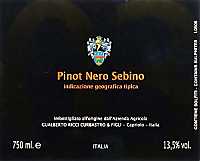
|
|
Pinot Nero 2000 |
|
| Ricci Curbastro (Lombardy, Italy) | |
| Grapes: Pinot Noir | |
| Price: € 18.50 | Score: |
| This Pinot Noir shows a brilliant ruby red color and nuances of brick red, moderate transparency. The nose reveals intense, clean, pleasing, refined and elegant aromas that start with hints of cherry, plum and dried rose followed by aromas of strawberry, licorice, vanilla, tar,menthol, blueberry, cocoa, cinnamon, clover, leather and tobacco. The mouth has good correspondence to the nose, a pleasing crisp and slightly tannic attack, however balanced by alcohol, full body, intense flavors, agreeable. The finish is persistent with flavors of cherry, plum and strawberry. A well made wine. This Pinot Noir ages for more than 18 months in barrique. | |
| Food Match: Game, Roasted meat, Braised and stewed meat with mushrooms, Hard cheese | |
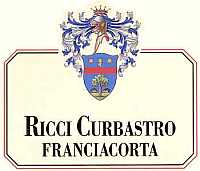
|
|
Franciacorta Extra Brut 2002 |
|
| Ricci Curbastro (Lombardy, Italy) | |
| Grapes: Chardonnay (50%), Pinot Noir (50%) | |
| Price: € 18.00 | Score: |
| This Franciacorta shows a brilliant golden yellow color and nuances of golden yellow, very transparent, fine and persistent perlage. The nose reveals intense, clean, pleasing, refined and elegant aromas that start with hints of hazelnut, grapefruit and bread crust followed by aromas of yeast, acacia, banana, apple, pear, pineapple, hawthorn, butter and plum. The mouth has good correspondence to the nose, an effervescent and crisp attack, however balanced by alcohol, good body, intense flavors, agreeable. The finish is persistent with flavors of grapefruit, banana and hazelnut. A well made wine. This Franciacorta Extra Brut ages in bottle on its lees for at least 42 months. | |
| Food Match: Roasted fish, Roasted white meat, Stuffed pasta, Fried fish, Broiled crustaceans | |
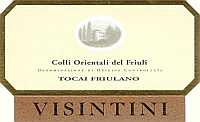
|
|
Colli Orientali del Friuli Tocai Friulano 2005 |
|
| Visintini (Friuli Venezia Giulia, Italy) | |
| Grapes: Tocai Friulano | |
| Price: € 10.00 | Score: |
| This wine shows a intense straw yellow color and nuances of greenish yellow, very transparent. The nose reveals intense clean, pleasing and refined aromas which start with hints of apple, pear and pineapple followed by aromas of almond, hawthorn, broom and plum. The mouth has good correspondence to the nose, a crisp attack and however balanced by alcohol, good body, intense flavors. The finish is persistent with flavors of apple, pear and almond. This Tocai Friulano ages in steel tanks. | |
| Food Match: Pasta and risotto with fish, White roasted meat, Roasted fish | |
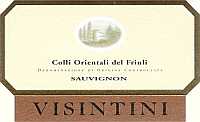
|
|
Colli Orientali del Friuli Sauvignon 2005 |
|
| Visintini (Friuli Venezia Giulia, Italy) | |
| Grapes: Sauvignon Blanc | |
| Price: € 10.00 | Score: |
| The wine shows a brilliant greenish yellow color and nuances of greenish yellow, very transparent. The nose denotes intense, clean, pleasing and refined aromas which start with hints of peach, litchi and pear followed by aromas of nettle, pineapple, elder and broom. The mouth has good correspondence to the nose, a crisp attack and however balanced by alcohol, good body, intense flavors. The finish is persistent with flavors of peach, litchi and pineapple. This Sauvignon ages in steel tanks. | |
| Food Match: Pasta and risotto with crustaceans and vegetables, Vegetables soups, Sauteed fish | |
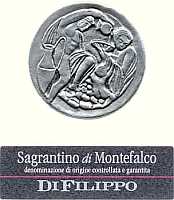
|
|
Sagrantino di Montefalco 2003 |
|
| Di Filippo (Umbria, Italy) | |
| Grapes: Sagrantino | |
| Price: € 20.90 | Score: |
| This Sagrantino di Montefalco shows an intense ruby red color and nuances of ruby red, little transparency. The nose denotes intense, clean, pleasing and refined aromas which start with hints of plum, blackberry and black cherry followed by aromas of violet, vanilla, tobacco, carob and mace. The mouth has good correspondence to the nose, a tannic attack and however balanced by alcohol, full body, intense flavors. The finish is persistent with flavors of black cherry, plum and blackberry. This Sagrantino di Montefalco ages for 12 months in cask. | |
| Food Match: Game, Roasted meat, Braised and stewed meat, Hard cheese | |

|
|
Poggio Madrigale 2001 |
|
| Di Filippo (Umbria, Italy) | |
| Grapes: Sangiovese, Merlot, Montepulciano | |
| Price: € 14.90 | Score: |
| Poggio Madrigale shows a brilliant ruby red color and nuances of garnet red, moderate transparency. The nose reveals intense, clean, pleasing and refined aromas which start with hints of plum jam, black cherry jam and dried violet followed by aromas of blueberry jam, vanilla, carob, tobacco, licorice and menthol. The mouth has good correspondence to the nose, a tannic attack and however balanced by alcohol, good body, intense flavors. The finish is persistent with flavors of plum jam and black cherry jam. Poggio Madrigale ages for 24 months in cask. | |
| Food Match: Roasted meat, Braised and stewed meat with mushrooms, Hard cheese | |
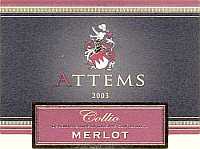
|
|
Collio Merlot 2003 |
|
| Attems (Friuli Venezia Giulia, Italy) | |
| Grapes: Merlot | |
| Price: € 9.00 | Score: |
| This Merlot shows an intense ruby red color and nuances of garnet red, moderate transparency. The nose denotes intense, clean, pleasing and refined aromas that start with hints of black cherry, plum and black currant followed by aromas of vanilla, tobacco, cinnamon, chocolate, pink pepper, licorice and menthol. The mouth has good correspondence to the nose, a slightly tannic attack and pleasing roundness, however balanced by alcohol, good body, intense flavors. The finish is persistent with flavors of black cherry, plum and black currant. Collio Merlot ages for 14 months in barrique, 2 months in steel tanks and 4 months in bottle. | |
| Food Match: Broiled meat and barbecue, Sauteed meat, Stewed meat | |
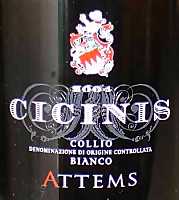
|
|
Collio Bianco Cicinis 2004 |
|
| Attems (Friuli Venezia Giulia, Italy) | |
| Grapes: Sauvignon Blanc, Tocai Friulano, Pinot Blanc | |
| Price: € 17.00 | Score: |
| Collio Bianco Cicinis shows an intense golden yellow color and nuances of golden yellow, very transparent. The nose reveals intense, clean, pleasing and refined aromas which start with hints of plum, honey and almond followed by aromas of vanilla, hawthorn, citrus fruit peel, apple, litchi, peach jam, pineapple and bergamot. The mouth has good correspondence to the nose, a crisp attack and pleasing roundness, however balanced by alcohol, good body, intense flavors, agreeable. The finish is persistent with flavors of plum, almond and pineapple. A well made wine. Collio Bianco Cicinis ages for 12 months in barrique followed by 2 months of aging in bottle. | |
| Food Match: Roasted white meat, Roasted fish, Stuffed pasta with cheese | |
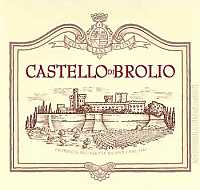
|
|
Chianti Classico Castello di Brolio 2001 |
|
| Barone Ricasoli (Tuscany, Italy) | |
| Grapes: Sangiovese (85%), Cabernet Sauvignon, Merlot (15%) | |
| Price: € 26.50 | Score: |
| Chianti Classico Castello di Brolio shows an intense ruby red color and nuances of garnet red, little transparency. The nose reveals intense, clean, pleasing, refined and elegant aromas which start with hints of black cherry, plum and black currant followed by aromas of violet, blueberry, vanilla, tobacco, licorice, cocoa, cinnamon, mace and eucalyptus. The mouth has good correspondence to the nose, a tannic attack and however balanced by alcohol, good body, intense flavors, agreeable. The finish is persistent with flavors of black cherry, black currant and plum. A well made wine. Chianti Classico Castello di Brolio ages for 18 months in barrique followed by 8 months of aging in bottle. | |
| Food Match: Roasted meat, Braised and stewed meat with mushrooms, Hard cheese | |
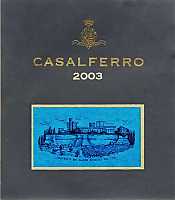
|
|
Casalferro 2003 |
|
| Barone Ricasoli (Tuscany, Italy) | |
| Grapes: Sangiovese, Merlot | |
| Price: € 25.00 | Score: |
| Casalferro shows a deep ruby red color and nuances of garnet red, little transparency. The nose reveals intense, clean, pleasing, refined and elegant aromas which start with hints of black cherry, plum and black currant followed by aromas of violet, blackberry, vanilla, toasted wood, tobacco, menthol, mace, licorice, chocolate, cinnamon and leather. The mouth has a very good correspondence to the nose, a tannic attack and however balanced by alcohol, full body, intense flavors, agreeable. The finish is very persistent with long flavors of black cherry, plum and black currant. A well made wine. Casalferro ages for 18 months in barrique. | |
| Food Match: Game, Roasted meat, Braised and stewed meat, Hard cheese | |
Umani RonchiFounded in the 1950s by Dr. Gino Umani Ronchi, this prestigious winery is now property of Bianchi Bernetti family and it is among the most representative wineries of Marches |
|
In the last years the role and the scenery of the enology in the Marches has changed a lot, they have mainly focused - here as somewhere else in Italy - to quality as the primary key for success and mostly based on the autochthonous grapes of the region. Verdicchio has been the first autochthonous grape of the Marches to contribute to the success of the wines of this region, a success which is still today alive and which can be considered - undoubtedly - among the best white wines of Italy. Marches are not Verdicchio only, of course. In the last years are getting more and more famous also the red wines of this region, in particular Rosso Conero, the robust wine from Marches produced with Montepulciano and Sangiovese grapes. To catch the attention of wine lovers towards the enological production of Marches, besides typical wines, there are also the many wines classified as Indicazione Geografica Tipica (IGT, Typical Geographical Indication) produced with the so called “international” grapes.
Umani Ronchi is one of the wineries which contributed to the notoriety of wines from Marches all over the world, today considered one of the most prestigious wineries of Italy. Founded in the 1950s by Dr. Gino Umani Ronchi in Cupramontana, the winery was acquired some years later by the Bianchi Bernetti family, who are still the current owners. In the 1970s were built the two wineries of Castelbellino and Osimo, both in the province of Ancona. The winery at Castelbellino was destined to the vinification of Verdicchio grape, whereas the one at Osimo was destined to the vinification of Rosso Conero and to the bottling of the whole production of Umani Ronchi. Beginning from the 1990s, Umani Ronchi winery is led by Massimo Bernetti - who is the current president - and by his son Massimo, who is in charge for the management of the winery. This change has started a new course at Umani Ronchi, beginning an activity of innovation and research, two fundamental factors in the daily activities of this winery and which also allowed the reorganization and requalification of the whole productive structure. In 2000 has been restored the main winery at Osimo, in which was also built a new room for the aging of wines in casks as well as a tasting room. The expansion of Umani Ronchi also spread to the neighboring Abruzzo region. In fact, in 2002 were acquired 30 hectares of estates inside the area of “Colline Teramane” for the production of Montepulciano d'Abruzzo. In 2004 was also inaugurated a wine shop, where wine lovers can taste the wines produced by Umani Ronchi. Moreover, in 2005 have been introduced new agricultural methods in vineyards, by using different cultural methods according to each variety.
Red berried grapes are currently cultivated with the spurred cordon system, whereas for white berried grapes is used the simple Guyot method instead. Today the properties of Umani Ronchi cover an area of 110 hectares of vineyards in the production area of Verdicchio Classico, 60 hectares in the Rosso Conero area and, finally, 30 hectares in the Montepulciano d'Abruzzo area, for a total of 200 hectares. The new estates at Roseto degli Abruzzi follows the same productive and qualitative criteria of Umani Ronchi, which in this area will be focused on the production of Montepulciano d'Abruzzo “Colline Teramane” DOCG. The estate is located in the Casal Thaulero area, in the province of Teramo, where it was built a new vinification cellar, considered a strategical future production center for new wines. Umani Ronchi aims in fact to adopt the same criteria which have ensured the success of their products in the Marches, while keeping the control on every production phase and investing on development and innovation in regard to quality. Despite the productive philosophy of Umani Ronchi is mainly focused on the valorization of the autochthonous grapes of Marches and Abruzzo, such as Verdicchio and Montepulciano, particular attention is paid to “international” varieties. In its research and experimentation activities, Umani Ronchi also includes Chardonnay, Sauvignon Blanc, Cabernet Sauvignon and Merlot varieties, obtaining results of remarkable interest. One of the most famous wines of Umani Ronchi produced with international grapes is Pelago - produced with Cabernet Sauvignon, Montepulciano and Merlot, ages in barrique for 14 months - a wine which has received prizes and appreciation in every country of the world. Prizes and appreciation that Umani Ronchi also receives with the wines produced with the autochthonous grapes of Marches, such as Rosso Conero Cumaro - produced with 100% Montepulciano - and the excellent Verdicchio Casal di Serra Vecchie Vigne and Plenio. Umani Ronchi is particularly focused on the experimentation and research, a job done with the cooperation of the University of Ancona and the contribution of wine maker Beppe Caviola. A research done in respect of the varietal characteristics of every grape but with the goal of studying the potentialities of every variety. Wines produced by Umani Ronchi are divided into five families and, despite in each family there are wines produced with the same grapes, they express distinct characteristics by means of the valorization of every vineyard and every variety. Thanks to this productive philosophy, Umani Ronchi is appreciated all over the world for the quality of its wines. The eighty percent of the production is in fact exported in 50 countries of the world and of which the main markets are United States of America, Germany, Japan and England. The success distinguishing Umani Ronchi since many years is based on quality and research, something which is clearly confirmed by its wines that, unfailingly, are appreciated every year by the many wine lovers in Italy and in the world.
|
||||||||||||||||||||
|
Score legend Prices are to be considered as indicative. Prices may vary according to the country or the shop where wines are bought |
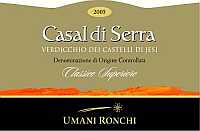
|
|
Verdicchio dei Castelli di Jesi Classico Superiore Casal di Serra 2005 |
|
| Umani Ronchi (Marches, Italy) | |
| Grapes: Verdicchio | |
| Price: € 10.00 | Score: |
| This Verdicchio shows a pale straw yellow color and nuances of greenish yellow, very transparent. The nose denotes intense, clean, pleasing and refined aromas which start with hints of pear, apple and hawthorn followed by aromas of almond, pineapple, citrus fruits, peach, plum and hints of mineral. The mouth has good correspondence to the nose, a crisp attack and however balanced by alcohol, good body, intense flavors, agreeable. The finish is persistent with flavors of apple, pear and almond. Verdicchio Casal di Serra ages in steel tanks. | |
| Food Match: Pasta with fish, Roasted white meat, Stewed and broiled fish | |
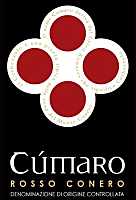
|
|
Rosso Conero Cumaro 2003 |
|
| Umani Ronchi (Marches, Italy) | |
| Grapes: Montepulciano | |
| Price: € 18.00 | Score: |
| The wine shows an intense ruby red color and nuances of ruby red, little transparency. The nose denotes intense, clean, pleasing and refined aromas which start with hints of black cherry, plum and blueberry followed by aromas of violet, vanilla, black currant, carob, tobacco, blackberry, mace and menthol. The mouth has good correspondence to the nose, a tannic attack and however balanced by alcohol, good body, intense flavors. The finish is persistent with flavors of black cherry, plum and blueberry. Rosso Conero Cumaro ages for 14 months in cask followed by at least 7 months of aging in bottle. | |
| Food Match: Roasted meat, Stewed and braised meat with mushrooms, Hard cheese | |
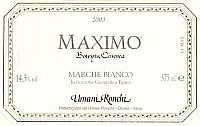
|
|
Maximo 2003 |
|
| Umani Ronchi (Marches, Italy) | |
| Grapes: Sauvignon Blanc | |
| Price: € 17.00 - 375ml | Score: |
| Maximo shows a brilliant amber yellow color and nuances of amber yellow, transparent. The nose denotes intense, clean, pleasing and refined aromas which start with hints of dried apricot, honey and almond followed by aromas of dried fig, peach jam, candied fruit, litchi, melon, citrus fruit peel, pear and nail polish. The mouth has good correspondence to the nose, a sweet attack and pleasing crispness, however balanced by alcohol, good body, intense flavors, agreeable. The finish is persistent with flavors of dried apricot, melon and honey. Maximo is produced with grapes affected by Botrytis Cinerea (noble rot) and ages in steel tanks. | |
| Food Match: Confectionery, Hard cheese | |
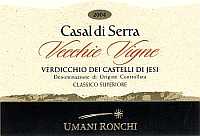
|
|
Verdicchio dei Castelli di Jesi Classico Superiore Casal di Serra Vecchie Vigne 2004 |
|
| Umani Ronchi (Marches, Italy) | |
| Grapes: Verdicchio | |
| Price: € 13.00 | Score: |
| This wine shows a brilliant golden yellow color and nuances of golden yellow, very transparent. The nose denotes intense, clean, pleasing and refined aromas which start with hints of apple, plum and almond followed by aromas of citrus fruits, hawthorn, chamomile, broom, pineapple, hazelnut, pear and citrus fruit peel. The mouth has good correspondence to the nose, a crisp attack and pleasing roundness, however balanced by alcohol, good body, intense flavors, agreeable. The finish is persistent with flavors of apple, plum and almond. A well made wine. Verdicchio Casal di Serra Vecchie Vigne ages in cement tanks. | |
| Food Match: Roasted white meat, Roasted fish, Stuffed pasta, Mushrooms soups | |
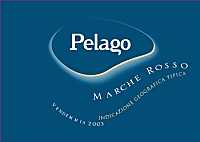
|
|
Pelago |
|
| Umani Ronchi (Marches, Italy) | |
| Grapes: Cabernet Sauvignon (50%), Montepulciano (40%), Sangiovese (10%) | |
| Price: € 30.00 | Score: |
| Pelago shows a deep ruby red color and nuances of ruby red, little transparency. The nose reveals intense, clean, pleasing, refined and elegant aromas which start with hints of black cherry, plum and black currant followed by aromas of blueberry, blackberry, violet, vanilla, licorice, tobacco, chocolate, eucalyptus and hints of lavender. The mouth has good correspondence to the nose, a tannic attack and however balanced by alcohol, full body, intense flavors, agreeable. The finish is persistent with flavors of black cherry, plum and black currant. A well made wine. Pelago ages for 14 months in barrique followed by 12 months of aging in bottle. | |
| Food Match: Roasted meat, Game, Braised and stewed meat, Hard cheese | |
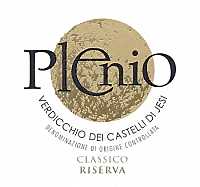
|
|
Verdicchio dei Castelli di Jesi Classico Riserva Plenio 2003 |
|
| Umani Ronchi (Marches, Italy) | |
| Grapes: Verdicchio | |
| Price: € 13.00 | Score: |
| This wine shows a brilliant golden yellow color and nuances of golden yellow, very transparent. The nose reveals intense, clean, pleasing, refined and elegant aromas which start with hints of pear, apple and almond followed by aromas of vanilla, honey, peach jam, citrus fruits, pineapple, hawthorn, hazelnut, plum and mineral. The mouth has good correspondence to the nose, a crisp attack and pleasing roundness, however balanced by alcohol, good body, intense flavors, agreeable. The finish is very persistent with long flavors of apple, plum and almond. A well made wine. Verdicchio Riserva Plenio ferments in part in barrique and ages for 8 months in cement tanks followed by 6 months of aging in bottle. | |
| Food Match: Roasted white meat, Roasted fish, Stewed fish, Stuffed pasta, Mushrooms soups | |
| Umani Ronchi - SS 16 Km 310+400, 74 - 60027 Osimo, Ancona (Italy) - Tel. +39 71 7108019 Fax: +39 71 7108859 - Winemaker: Emidio Felicetti with the support of Beppe Caviola - Established: 1955 - Production: 4.400.000 bottles - E-Mail: wine@umanironchi.it - WEB: www.umanironchi.it |
Cellar Journal |
|
This section is reserved to wine producers who want to publish news and information about their business, to announce new products or just for communicating to customers information and promotions about their products and activity. Send news to be published to our e-mail address.
|
News |
|
In this section are published news and information about events concerning the world of wine and food. Whoever is interested in publishing this kind of information can send us a mail to our address.
|
Making Wine: Alcoholic FermentationThe fundamental and indispensable process which will reveal the real qualities of the grape, a complex chemical phenomenon which will transform the must into wine |
|
After having crushed the grapes, obtained the must and having done the proper corrections, it has now come the time to let our grape juice begin the journey which - by means of a complex chemical process - will transform it into wine. Alcoholic fermentation - or primary fermentation - is a fundamental process for the production of wine. Its role is not only limited to the transformation of sugar into alcohol and carbon dioxide - as well as other byproducts - indeed, it is what defines, or better to say, reveals, the organoleptic qualities of the grape. In fact, all the potential qualities of a wine are, like to say, hidden in the grape: they will be revealed or they will disappear forever by means of alcoholic fermentation and during the other phases of vinification. The role of alcoholic fermentation is fundamental for the development of aromatic and gustatory qualities of a wine, it is not by chance it is said “primary aromas are hidden in the grape, but it is fermentation which will reveal them”.
Fermentation is a natural process allowing the transformation of grape juice - the must - into wine. Alcoholic fermentation, or primary fermentation, can be considered as a chain reaction of chemical phenomena. During these processes, the sugar contained in the grape juice is converted by yeast's enzymes into ethyl alcohol and carbon dioxide. According to the type of yeast, from the conversion of sugar is obtained about 50% of alcohol, 45% of carbon dioxide, 3% of glycerol and 2% of other byproducts. This complex phenomenon, unknown for centuries, produces other substances as well, considered as “byproducts” and which play an essential role in the aromatic and gustatory qualities of wine. Of these products, the most important ones are acetaldehyde, acetic acid, ethyl acetate, glycerol and other types of alcohol. These “secondary” products are in fact essential for the development of any wine's aromatic qualities and, depending on how the alcoholic fermentation was done, aromas can get refined or spoiled. Fermentation is an extremely complex process which is the result of more than consecutive reactions caused the yeast's enzymes, the unicellular microorganisms which use the sugar found in the must in order to ensure their growth and multiplication. The most common type of yeast used in enology is Saccharomyces Cerevisiae, also used for the fermentation of beer and the leavening of bread. The entire process is done in anaerobic conditions, that is without oxygen, therefore yeast produces energy by converting sugar. In the initial phases of fermentation, yeasts do an aerobiotic respiration, that is they use the oxygen found in the must, therefore transforming the sugar into water and carbon dioxide. When in the must there is no more oxygen, the real fermentation begins - a process done in anaerobic conditions - during which the yeast produces energy by the oxidation of sugar and transforming it into ethyl alcohol, carbon dioxide and other secondary products.
|
||||||||
|
The quality and quantity of primary and secondary substances produced during fermentation, basically depend on the conditions happening during this process. It is extremely important for the must to be in the best possible condition before the fermentation begins, in particular, it is essential it is not oxidized. For this reason, it is very important the fermentation of the must starts as soon as possible, soon after the normal operations of stabilization, decanting and clarification. During this phase the must is in fact particularly sensitive to the attacks of bacteria, spoilage caused by microbial activities and oxidation. For this reason, it is essential the period of pre-fermentation should be as short as possible and the must to be properly protected by adding sulfur dioxide. This practice allows in fact to do all the operations of decanting and clarification of the must without taking the risk of spoilage. Moreover, it is of fundamental importance the fermentation is done according the typical times for this process, a time which - according to the type of must, the operations done for its stabilization and the quality of the grapes - can be from 5 to 15 days. An excessively slow fermentation can in fact favor the development of secondary substances responsible for “ordinary” aromas and taste as well as an excessive quantity of volatile acidity. On the contrary, in case the fermentation is too fast, this will cause an excessive increasing of temperature and a loss of aromas - which will be lost with the huge quantity of carbon dioxide released during the process - with the result of obtaining an ordinary wine having no pleasing organoleptic qualities. Temperature plays a fundamental role for fermentation. According to the type of wine to be made, it is essential the temperature is kept constant within a specific range, as we will see later. A too low temperature - usually lower than 15° C (59° F) - inhibits in fact the start and the process of fermentation, while increasing the risks of oxidation or, in case of red wines, an insufficient extraction of color. Too high temperatures will cause a too rapid fermentation with the risk of obtaining a coarse wine and pretty ordinary, lacking of any quality of finesse. An excessively high temperature causes the interruption of fermentation as well as the death of yeast. Temperature is also important during the adding of selected yeast to the must. It is important the temperature of selected yeast is as equal as possible to the one of the must to which they will be added, as an excessive difference of temperature can cause the death of most of the yeast, therefore making useless this operation. Finally, it is good to remember selected yeast must be added to the must before the beginning of the fermentation process.
|
||||
|
For the fermentation of white wines it will be used a must from which will be eliminated the skins soon after having crushed the grapes. In order to have a better fermentation and a more stable wine, it will also be appropriate to clarify and decant the must in order to eliminate any solid substance before starting fermentation, as already mentioned in past articles published in DiWineTaste. The primary goal of fermentation of the must destined to the production of white wine is to keep finesse and quality of aromas, a result which is mainly obtained with a scrupulous control of the temperature and by keeping it from 16° and 20° C (60°-68° F). This range of temperatures will in fact allow the optimal development of aromas, a slow transformation of sugar and an excellent production of alcohol. Lower temperatures will make fermentation difficult and can also stop the whole process, therefore favoring the oxidation of the must. Higher temperatures will make fermentation excessively active, with the result of losing most of refined aromas, therefore obtaining a pretty coarse and ordinary wine. For this reason, during the fermentation of white wines, it will be scrupulously controlled the temperature by making sure it does not go outside the correct range. Fermentation is a process developing heat, therefore it is very likely the temperature easily raises above 20° C (68° F), in particular during mild seasons. The best method to cool the fermentation tank down, in case there are no automatic systems for the control of temperature, is to run cold water along the sides of the tank. In case temperature gets too low, it can be used the same method by using lukewarm water. Another method consists in heating the room where are found the fermentation tanks. It is not recommended to warm the must by plunging electric heaters or similar systems, because this can cause the excessive heating of the must in contact with the heater therefore developing “burnt” tastes.
|
|
For the fermentation of red wines will be used a must in which will be allowed skins to macerate, an essential operation allowing the extraction of color. It will be the extraction of color and polyphenolic substances, one of the primary goals in the alcoholic fermentation of red wines. Coloring substances contained in the skins can be easily extracted at higher temperatures, and the higher the temperature, the better the extraction of coloring substances and polyphenolic substances, in other words, a red wine fermented at a higher temperature will have a fuller structure and body. Also in this case it is of fundamental importance to control temperature, by making sure it does not go outside the optimal range, which for red wines is from 25° and 30° C (77°-86° F). This temperature allows the production of red wines with good quality, a good extraction of color and polyphenolic substances, as well as a good balance between these two qualities. Temperatures lower than 20° C (68° F) will make difficult the extraction of coloring substances from the skin, therefore it is always recommended to not allow temperature to get so low. Temperatures from 20° and 25° C (68°-77° F) will allow a moderate extraction of coloring substances, however not enough for the optimal extraction of polyphenolic substances, with the result of obtaining a light wine and with a light body. Temperatures included in this range are recommended for light red wines, not destined to aging and to be consumed within the year. Temperature higher than 30° C (86° F) make wines rich in polyphenolic substances as well as robust, however the fermentation could cause the development of taste with a pronounced “herbaceous” quality and, in case it is not properly controlled, this can also interrupt the fermentation process. Such high temperatures are sometimes useful for the fermentation of grapes having little coloring substances, such as Pinot Noir. In this specific case, after the first racking, that is the separation of the skins from the wine, it is recommended to complete fermentation at a temperature of about 20° C (68° F), in order to allow an optimal development of aromas and the best condition for malolactic fermentation.
|
|
The normal conditions for wine home making do not always allow scrupulous controls on fermentation because specific laboratory tools are not usually available. However, also in wine home making it is indispensable to properly control the process of fermentation in order to ensure the best possible result. Of all the controls usually done on fermentation, two of them are considered to be of fundamental importance: the control of temperature and the control of density. These two controls are indispensable and they will be done on a daily basis, carefully writing down the results in a record, in order to get a trend of the fermentation and the changes of the two values according to time. The control of temperature is very easy to do: it will be enough to detect it from the fermentation mass by using a thermometer. In case temperature is outside the optimal range for the wine to be made, it will be necessary to properly correct it by using the methods discussed above. The control of density is very simple to do as well and it allows the verification of the good progressing of fermentation and, in particular, to realize when it is interrupted before the normal end. The control of density can be easily done by using a normal densimeter, the same used for the control of grape's ripeness. During fermentation, the density of the must progressively diminishes, until reaching a value from 0.990 to 0.995. Values greater than 1 mean the presence of sugar, therefore the fermentation is not completed yet. In case density gets stabilized on a value greater than 1, it means the fermentation is stopped and it is then necessary to restart it as soon as possible. The most common cause is a variation of temperature and therefore it will be necessary to take proper action. This phenomenon is properly detected by controlling the density as, after the fermentation is stopped, carbon dioxide continues to develop from the tank - just like the normal progressing of fermentation - and when it completely stops it is usually to late and no remedy is useful.
|
Maize - CornFor ancient civilizations of Latin America it was considered the plant of life, an irreplaceable means of support which is still today common in many countries of the world |
|
For many people maize was considered the plant of life. Today this plant is getting more and more common, also for the use in animal's nutrition, however it is, for many people, the main means of support. «They then brought bread, many fruits, red and white wine, not made of grape, indeed they were made with fruits, the red was of a type and the white of another, as well as some other wine made of maiz which is a sort of grain contained in a spike similar to a panicle which I brought in Castilla where it is quite common already; it seems the best one is considered of having great excellence and great value». This wrote Christophorus Columbus in his letter-report for the Sovereign Catholics during his third journey, in 1498.
|
|
Maize, also known as corn and whose scientific name is Zea Mays, is an annual herbaceous plant belonging to the family of Graminaceae. Researches done on this plant suggest it derives from a small wild plant from Mexico and Guatemala: teosinte. Biologists of the University of California have in fact discovered in maize the presence of the barren stalk 1 gene who relates this plant to teosinte. This gene allowed the agriculturists of Central America lived 7,000 years ago to obtain maize. The name maize comes from the term Maiz of Arauca origins. The state of Arauca is one of the departments in Columbia and it is found in the central part, near the borders with Venezuela. The cultivation of maize is believed to began about 7,500 years ago. In the New Mexico has been found the most ancient variety and its cultivation spread from Southern-Central America to north in the region of great lakes.
Maize, for the people of Central America, has a fundamental importance, it was the base element for the diet, a plant deeply associated to the survival of people and it was also part of Mayan mythology. According to Maya legends, man was created from a small ball of maize and water. Maize has such a dignity and importance as to deserve a god on its own, Yum Kaa, the god of maize. Also Aztecs had a god dedicated to the maize - Centeotl - and they too had ceremonies and sacrificial rites associated to the maturation cycle of the plant. One of these sacrificial ceremonies was done when maize was ripe: a young woman was beheaded representing the harvesting of maize cobs. At the end of harvesting, a second young woman was killed and skinned, a representation of maize decortication. Many other legends and tradition connects the people of the New World to the cultivation of maize. Ancient people of Central America, cultivated maize together with climbing plants of beans, by letting them to climb to the high stalk of maize. It was, for many years, the base cereal for the nutrition of Maya, Aztecs, the ancient people of Nevada state and Inca in Peru. Machica and Chimu people (along the northern coast of Peru) also made an alcoholic beverage from it. To introduce maize in Europe was certainly the famous explorer Christophorus Columbus. As soon as it arrived in the Old World, it slowly spread in Italy and in France. In these countries it had a slow spreading because, according to the historical witnesses of those times, it required a too fertile soil and alternative cultivations, such as hemp, ensured a more profitable income. The new cereal also spread in the Balkans and it spread very quickly because it ensured a higher yield, sometimes as much as twice, than the traditional grains. Moreover, as it was not included in the list of “imposed” cereals by law, it was, for the moment, a product exempted from taxes. In later times the cultivation of maize spread from Italy to Germany and then it spread all over the Mediterranean area. In Italy its spreading began in the Po valley by using the “three fields” technique: one cultivated with maize and two with wheat. The field cultivated with maize ensured the essential support for nutrition - polenta - whereas the other two produced wheat to be used for paying taxes. In the last 40 years the production of maize in Italy has raised significantly, both in quantity and in quality. The new hybrid varieties ensure yields of about 12-15 tons per hectare, instead for the 2-3 tons which could be usually obtained with the old varieties. With these yields, maize has become very productive according to an economic point of view and from marginal soils, it now occupies the fertile and well irrigated soils, in order to get the most out from production. Northern Italy is the area in which it is concentrated 33% of national production. To introduce the cultivation of maize in Spain were Arabs, who imported from Turkey the cultivation techniques. This explains the origin of the term “Turkish wheat”. Also Portuguese knew about this new plant and they exported it in their colonies, therefore, thanks to them, it was introduced in Africa, and in the colonies of Southern Asia, and from here, it was introduced in China. It was the second half of the 1500s. In 1775 maize was introduced in Japan, however it is not clear how this happened. Carl Nilsson Linnaeus, better known with the Latin name Linnaeus, the great Swedish biologist and creator of the modern scientific nomenclature for the classification of plants and animals, was the first to have the need to give the new plant an official name, therefore it was named Zea Mays. The name comes from a research done in ancient classical books, the “grano primus antiquis Latio cibus”, as it was called by Pliny the Elder, or the cereal of life “zea”, as it was mentioned in the Odyssey. These two definitions certainly were not referred to maize and Linnaeus knew it very well, however he liked the concept of “cereal of life” and therefore he decided to call it “zea”. The term “mays” is found in the book “Historia natural y moral de las Indias” (Natural and moral history of Indies) written by the Jesuit Josè de Acosta in 1590.
|
||||||||||||
|
Maize is an annual herbaceous plant, it prefers a fertile soil, well drained, with a full exposition to sun rays. The stalk can reach two or three meters in height and it ends with an inflorescence, called panache, whereas at the base of leaves are found female inflorescences: the cobs. The production of cobs varies according to the variety of the plant. Some produce just few cobs, whereas other may also produce more than twenty. Although the most common type of maize has a yellow color, there are also other varieties with white, purple, blue, red, pink and black grains, as well as of other colors. The difference of the colors in grains depends on the different concentration of carotenoids and flavonoids, contained in the external part of the grain. Maize is not used for human nutrition only: it is widely used for the nutrition of animals, in the production of liquors, beer and in the production of 100% biodegradable plastic. With maize is also made the famous “popcorn”, from the buds is produced maize oil. Maize syrup is made from grains' starch, which is processed with two enzymes found in two fungi. The syrup increases elasticity and consistency of foods, slows down the loss of humidity, therefore increasing keeping time. In the countries of Andes, it is used for the production of a beer with a low alcohol by volume, obtained by the fermentation of maize and other cereals: a tradition going back to the times of Inca empire. Food industry uses it in the production of traditional baked products, in particular products destined to subjects with gluten allergy, and in the preparation of precooked foods. Paper industry uses it as an additive for improving or rectify the quality of cellulose paste. Pharmaceutical industry uses it as a “vehicle” for many medicines and for the production of soap. From the refinement of maize is produced maizena (maize starch), used in cooking as a thickener. To make a soup or a sauce thicker, it is enough to melt some maize starch in little cold broth, milk or water: for 500gr of sauce it is enough one spoonful. Maizena can replace, totally or in part, wheat flour in the preparation of cakes or puddings. In herbal medicine it is used dried maize silk which has diuretic, depurative, hypotensive and anti inflammatory properties. Maize is poor in lysine - an essential aminoacid which must be introduced by food intake as the body cannot synthesize it - and tryptophan. Therefore, 60-80% of vitamin B3 contained in maize cannot be assimilated by the human body. These characteristics explain why some people who mainly based their nutrition on maize suffered from pellagra, which was caused by the lack of lysine which in turn caused the lack of niacin, therefore causing pellagra. Not all the people who based their nutrition of maize suffered from this disease. Mesoamerican people learned how to properly eat maize: they boiled it in alkaline substances, also adding lime; in this way it was diminished the content of lysine while increasing the content in vitamin B3. One hundred grams of maize provide 355 calories and contain 2.20g of fibers, 66g of starch, 75.8g of sugars, 3.80g of lipids, 9.20g of proteins, 62mcg of vitamin A, 0.36mg of vitamin B1, 0.2mg of vitamin B2, 1.5mg of vitamin PP, 256mg of phosphor, 2.4mg of iron and 15mg of calcium. In occasion of the international forum for agriculture and nutrition in November 2006, was presented the “belu” water bottle, having a similar look of a normal plastic bottle, however completely made from maize, therefore completely biodegradable. To make a bottle are needed 65 grams of maize, to make a plastic bottle are used 0.027 liters of petroleum as well as the release of 0.04 kilograms of carbon dioxide in the atmosphere. Preferring “maize plastic” also means safeguarding the environment where we all live in.
|
AquavitaeReview of Grappa, Distillates and Brandy |
|
|
| Distillates are rated according to DiWineTaste's evaluation method. Please see score legend in the "Wines of the Month" section. |

|
|
Most Uve Rosse Nobili |
|
| Bepi Tosolini (Friuli Venezia Giulia, Italy) | |
| Raw matter: Cabernet Franc, Refosco dal Peduncolo Rosso, Montepulciano | |
| Price: € 35.00 - 70cl | Score: |
| This grape brandy is colorless, limpid and crystalline. The nose reveals intense, clean, pleasing and refined aromas of raspberry, strawberry, cherry, blackberry, plum and cyclamen with imperceptible alcohol pungency. In the mouth has intense flavors with perceptible alcohol pungency which tends to dissolve rapidly, excellent correspondence to the nose, balanced sweetness, pleasing roundness. The finish is very persistent with long flavors of strawberry, raspberry and cherry. Most Uve Rosse Nobili is distilled with steam operated discontinuous alembic still and ages for at least 12 months. Alcohol 40%. | |
|
|
|
Grappa di Pinot Nero Oltrepo Pavese |
|
| Il Montù (Lombardy, Italy) | |
| Raw matter: Pomace of Pinot Noir | |
| Price: € 17.14 - 70cl | Score: |
| This grappa is colorless, limpid and crystalline. The nose denotes intense, clean, pleasing and refined aromas of cherry, plum, raspberry, strawberry, hazelnut, licorice and rose with almost imperceptible alcohol pungency. In the mouth has intense flavors with alcohol pungency which tends to dissolve rapidly, good correspondence to the nose, balanced sweetness. The finish is persistent with flavors of cherry, raspberry and strawberry. This grappa is distilled with a discontinuous bainmarie alembic still. Alcohol 40%. | |

|
|
Grappa Giovane |
|
| Distilleria Zanin (Veneto, Italy) | |
| Raw matter: Pomace of grapes from Veneto | |
| Price: € 10.00 - 70cl | Score: |
| The grappa is colorless, limpid and crystalline. The nose denotes intense, clean, pleasing and refined aromas of pear, banana, broom, apple and hazelnut with almost imperceptible alcohol pungency. In the mouth has intense flavors with perceptible alcohol pungency which tends to dissolve rapidly, good correspondence to the nose, good sweetness, pleasing roundness. The finish is persistent with flavors of apple and hazelnut. This grappa is distilled with a discontinuous alembic still. Alcohol 40%. | |
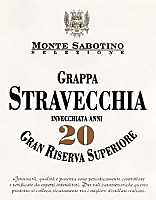
|
|
Grappa Stravecchia 20 anni Monte Sabotino |
|
| Distilleria Zanin (Veneto, Italy) | |
| Raw matter: Pomace of grapes from Veneto | |
| Price: € 50.00 - 70cl | Score: |
| This grappa shows a brilliant amber yellow color, limpid and crystalline. The nose reveals intense, clean, pleasing, refined and elegant aromas of praline, vanilla, licorice, tobacco, dried plum, hazelnut, dried fig and chocolate with almost imperceptible alcohol pungency. In the mouth has intense flavors with perceptible alcohol pungency which tends to dissolve rapidly, excellent correspondence to the nose, balanced sweetness, pleasing roundness. The finish is very persistent with long flavors of dried fig, dried plum, hazelnut and chocolate. This grappa is distilled with a discontinuous alembic still and ages for twenty years in cask. Alcohol 40%. | |
Wine Parade |
|
|
| The best 15 wines according to DiWineTaste's readers. To express your best three wines send us an E-mail or fill in the form available at our WEB site. |
| Rank | Wine, Producer | |
|---|---|---|
| 1 |
| Chianti Classico Riserva Novecento 2000, Dievole (Italy) |
| 2 |
| Nero al Tondo 2001, Ruffino (Italy) |
| 3 |
| Wine Obsession 2001, Vignamaggio (Italy) |
| 4 |
| Amarone della Valpolicella Classico 2000, Zenato (Italy) |
| 5 |
| Don Antonio 2003, Morgante (Italy) |
| 6 |
| Sagrantino di Montefalco Collepiano 2003, Arnaldo Caprai (Italy) |
| 7 |
| Brunello di Montalcino 1999, Castello Banfi (Italy) |
| 8 |
| Amarone della Valpolicella Classico Costasera 2001, Masi (Italy) |
| 9 |
| Soave Classico Monte Alto 2004, Ca' Rugate (Italy) |
| 10 |
| Notarpanaro 1999, Taurino (Italy) |
| 11 |
| Sforzato di Valtellina Canua 2001, Conti Sertoli Salis (Italy) |
| 12 |
| Sagrantino di Montefalco 2003, Antonelli (Italy) |
| 13 |
| Colli Orientali del Friuli Rosazzo Bianco Terre Alte 2002, Livio Felluga (Italy) |
| 14 |
| Barolo Cannubi Boschis 2001, Sandrone (Italy) |
| 15 |
| Barolo Bussia 2001, Prunotto (Italy) |
| |||||||
Privacy Policy | |||||||


| Copyright © 2002-2024 Antonello Biancalana, DiWineTaste - All rights reserved |
| All rights reserved under international copyright conventions. No part of this publication and of this WEB site may be
reproduced or utilized in any form or by any means, electronic or mechanical, without permission in writing from DiWineTaste. |